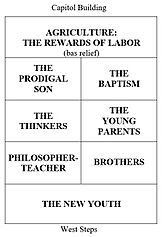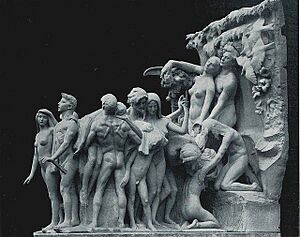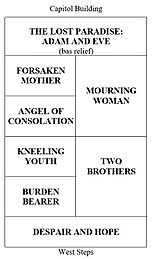George Grey Barnard facts for kids
Quick facts for kids
George Grey Barnard
|
|
|---|---|

Portrait of George Grey Barnard in 1908
|
|
| Born | May 24, 1863 Bellefonte, Pennsylvania, U.S.
|
| Died | April 24, 1938 (aged 74) New York City, U.S.
|
| Known for | Sculpture |
|
Notable work
|
Struggle of the Two Natures in Man Pennsylvania State Capitol sculpture groups Abraham Lincoln (Cincinnati) |
George Grey Barnard (May 24, 1863 – April 24, 1938) was an American sculptor. He is known for his large, powerful sculptures. Some of his most famous works include Struggle of the Two Natures in Man at the Metropolitan Museum of Art. He also created two big sculpture groups for the Pennsylvania State Capitol. Another well-known piece is his Lincoln statue in Cincinnati, Ohio. Barnard's art often used symbols to show deeper meanings. He also collected many old medieval art pieces. These pieces later became a main part of The Cloisters museum in New York City.
Contents
Life and Art of George Grey Barnard
George Grey Barnard was born in Bellefonte, Pennsylvania. He grew up in Kankakee, Illinois. His father was a minister.
Early Training and Success
Barnard first studied art at the Art Institute of Chicago. His talent was clear early on. He won a prize for a marble sculpture called Young Girl. This prize helped him go to Paris, France.
In Paris, he studied at a famous art school, the École nationale supérieure des Beaux-Arts. He also worked in the studio of Pierre-Jules Cavelier. Barnard lived in Paris for 12 years. He became very successful with his first art show in 1894.
He returned to America in 1896. He taught art at the Art Students League of New York from 1900 to 1903. He was even elected a member of the National Academy of Design in 1902.
Major Sculptures and Their Meaning
Barnard's early sculptures showed the influence of another famous sculptor, Auguste Rodin. One of his main works is Struggle of the Two Natures in Man (1894). This sculpture shows a deep idea about human nature. It is now at the Metropolitan Museum of Art in New York.
Another important work is The Great God Pan (1899). This large bronze sculpture was given to Columbia University. He also created The Hewer (1902) and Maidenhood (1896).
In 1911, Barnard finished two huge sculpture groups for the new Pennsylvania State Capitol. These groups are called The Burden of Life: The Broken Law and Love and Labor: The Unbroken Law. Together, they feature 27 figures that are larger than real life.
Lincoln Statue Controversy
Barnard's large statue of Abraham Lincoln (1917) caused some debate. People argued about its rough look and Lincoln's relaxed pose. The first version of this statue is in Lytle Park in Cincinnati, Ohio. Other versions are in Manchester, England (1919), and Louisville, Kentucky (1922).
Collecting Medieval Art
Barnard was very interested in medieval art. Before World War I, he collected old pieces of medieval buildings from French villages. He kept this collection in a special building in New York City. In 1925, John D. Rockefeller Jr. bought this collection. These pieces became a key part of The Cloisters museum, which is part of the Metropolitan Museum of Art.
Later Life and Passing
George Grey Barnard passed away on April 24, 1938, after a heart attack. He was working on a statue of Abel when he became ill. He is buried in Harrisburg Cemetery in Harrisburg, Pennsylvania.
Lorado Taft's View on Barnard's Art
Lorado Taft, another sculptor, wrote about George Grey Barnard in 1913. He noted Barnard's strong connection to the American West. Taft said Barnard's art had a "largeness" and "audacity." He also mentioned a "burning intensity" and a "strong element of mysticism" in Barnard's work.
Taft praised Barnard's early work, like Brotherly Love. He also highlighted Two Natures (Struggle of the Two Natures in Man) as a major achievement. Taft believed Barnard's work for the Pennsylvania Capitol was inspiring. He saw it as a sign of even greater things to come in American sculpture.
Selected Works
- The Boy (marble, 1885)
- Brotherly Love (Two Friends) (marble, 1886–87), Langesund, Norway.
- Struggle of the Two Natures in Man (marble, 1892–1894), Metropolitan Museum of Art.
- Maidenhood (Innocence) (1896), Brookgreen Gardens, Murrell's Inlet, South Carolina.
- Maiden with the Roses (Rose Maiden) (marble, 1898), Greenwood Cemetery, Muscatine, Iowa.
- Urn of Life (1898–1900), Carnegie Museum of Art, Pittsburgh, Pennsylvania.
- The Great God Pan (1899), Dodge Hall Quadrangle, Columbia University, New York City.
- Transportation – Henry Bradley Plant Fountain (1900), University of Tampa, Tampa, Florida.
- The Hewer (1902), Halliday Park, Cairo, Illinois.
- The Prodigal Son (1904). Part of the Pennsylvania State Capitol sculptures.
- Rising Woman (marble, c.1916), Kykuit, Pocantico Hills, New York.
- Statue of Abraham Lincoln (bronze, 1917), Lytle Park, Cincinnati, Ohio.
- Head of Abraham Lincoln (marble, 1919), Metropolitan Museum of Art.
- Let There Be Light (bronze, c.1922), Isaac Wolfe Bernheim monument, Bernheim Arboretum and Research Forest, Clermont, Kentucky.
- Adam and Eve Fountain (1923) Kykuit, Pocantico Hills, New York.
- The Refugee (Grief) (marble, by 1930), Metropolitan Museum of Art.
Gallery
Pennsylvania State Capitol Sculpture Groups
North group: Love and Labor: The Unbroken Law (marble, 1911), Pennsylvania State Capitol, Harrisburg.
South group: The Burden of Life: The Broken Law (marble, 1911), Pennsylvania State Capitol, Harrisburg.
Images for kids
Legacy
- Many artists studied under Barnard, including Anna Hyatt Huntington and Malvina Hoffman.
- Barnard gave 100 of his plaster models to the Kankakee County Museum in Kankakee, Illinois.
- A collection of his medieval architectural pieces is at the Philadelphia Museum of Art.
- The George Grey Barnard Sculpture Garden was created in his birthplace, Bellefonte, Pennsylvania, in 1978.









